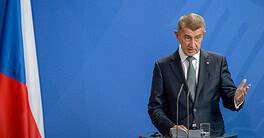Global Finance magazine interviewed National Bank of Denmark Governor Christian Kettel Thomsen, who was one of only three central bankers in the world to earn an “A+” grade in the magazine’s 2024 Central Banker Report Cards. Thomsen explains how Denmark pushed inflation to 1.5% and answers whether the country’s pharma industry is “too big to fail.”
Global Finance: Denmark’s inflation rate has dropped significantly from a high of 10% in late 2022 to stabilizing below 1.5% this year. What do you attribute to this better-than-average performance?
Christian Kettel Thomsen: The inflation job is basically done in Denmark after a series of unprecedented shocks led to extraordinarily high inflation in 2021-2023. Let me first offer some possible global explanations behind the road back towards price stability before turning to the specific Danish experience.
Despite the highest inflation in more than 40 years across advanced economies, medium-term inflation expectations generally remained well-anchored, underpinned by aggressive global monetary policy tightening and the credibility of independent central banks. In my view, this is a major difference compared to the past inflationary episodes of the 1970-80s, and key to understanding the nature of the rapid descent from the recent global inflationary surge which has so far occurred with surprisingly few negative effects to growth, employment, and financial stability. Aside from well-anchored inflation expectations, fading supply disruptions and restrictive economic policy also helped restore a better balance between aggregate demand and supply at the global level.
In Denmark, monetary policy is conducted with the aim of maintaining a fixed exchange rate vis-à-vis the euro. As such and over time, we import price stability from the euro area, which provides a focal point for analyzing our inflation development. Danish inflation has dropped faster than in the euro area in 2023-2024 amid a more rapid fall in energy prices, which has reduced price pressures both directly and indirectly via lower production costs, i.e., it appears that an asymmetric reaction in energy prices to a common shock helps to explain the low Danish inflation rate.
There has generally been substantial heterogeneity in the evolution of energy prices lately as EU countries differ in terms of market structures and fiscal measures taken to alleviate the impact of higher energy prices on households and businesses. Other idiosyncratic factors may also contribute to the low Danish inflation compared to the euro area. At the current juncture, goods inflation is for example particularly weak in Denmark.
Despite strong wage growth, underlying inflation remains modest, suggesting that profit margins may have absorbed the higher labor costs to a greater extent than originally anticipated.
Nevertheless, we expect Danish inflation to increase somewhat in the near-term as some of the wage increases feed through to consumer prices amid on-going labor market tightness, before stabilizing around 2% over the coming years.
GF: Do you plan to maintain the current interest rate differential with the Eurozone, or is there room to widen the gap, particularly with inflation now firmly under control?
Thomsen: Denmark has maintained a fixed exchange rate regime since 1982. First towards the German D-Mark and since 1999 towards the euro.
National Bank of Denmark’s mandate is to ensure stable prices by pegging the Danish krone to the euro. As part of the fixed exchange rate system, our monetary policy tools are reserved solely for maintaining the exchange rate between the Danish krone and the euro within a narrow band. Therefore, the interest rate cannot be used to stimulate the economic activity. We only change the policy rate spread to the euro area to secure the fixed exchange rate policy.
Even though pressure on the labor market is easing slightly, we are still in a situation of very low unemployment. Consequently, monetary and fiscal policy should contribute to an appropriate development in the business cycle in Denmark.
GF: As the global rate-cut cycle gains momentum, have you adjusted Denmark’s base economic projections for GDP growth and employment?
Thomsen: In our latest projection from September, assumptions about the global rate-cut cycle are generally in line with our assumptions from our previous projection—in March. Overall, recent developments support our projection from March, hence, our latest projection is generally similar to the one in March. However, employment has surprised to the upside.
During the past two years, Danish GDP growth has been supported by strong growth in the pharmaceutical sector which to a large extent can be attributed to production outside Denmark by Danish-owned companies. On the other hand, growth in most other parts of the economy has been relatively muted, which has resulted in less capacity pressure in the economy.
Despite sluggish activity growth, employment has risen at a higher pace than what normally would be expected. Large inflows of foreign labor and increases in the pension age have supported employment growth and contributed to an expansion of the labor force.
Going forward, we still expect high growth in the pharmaceutical sector to contribute to Danish GDP growth. At the same time growth on Danish export markets, further easing of monetary policy and higher real wages are expected to support growth in the Danish economy more broadly. In our September projection we expect GDP growth to be 2.1% this year, rising to 2.3% next year.
Employment is therefore expected to keep rising, supported by growth more broadly in the Danish economy. However, we expect employment to grow at a slower pace than seen during the past two years. This contrasts with our projection in March, where we expected a small decline in employment in 2024 and 2025.
GF: With Novo Nordisk now the largest company in Europe, do you see a risk of the Danish pharma industry becoming “too big to fail”? If so, how are you addressing that concern?
Thomsen: Novo Nordisk has a significant and growing impact on the Danish economy, which we fundamentally view as positive. This is also true for other large Danish companies that are successful internationally.
At the same time, we need to be mindful of how these companies influence various macroeconomic factors such as GDP, productivity and the balance of payments, so that we get an accurate picture of economic development. This is what we do, for instance, when we present figures that exclude the production these companies have abroad. At National Bank of Denmark, we are particularly concerned with the impact Novo Nordisk’s activities have on domestic capacity pressures, which ultimately affect inflationary pressure.
We do not believe that capacity pressures in Denmark have increased to the same extent as Novo Nordisk’s overall growth in the short term, as much of the activity and corresponding employment occurs in factories abroad under Danish ownership. In other words, we do not assess that the Danish economy is entirely dependent on Novo Nordisk.




